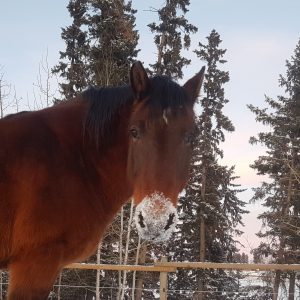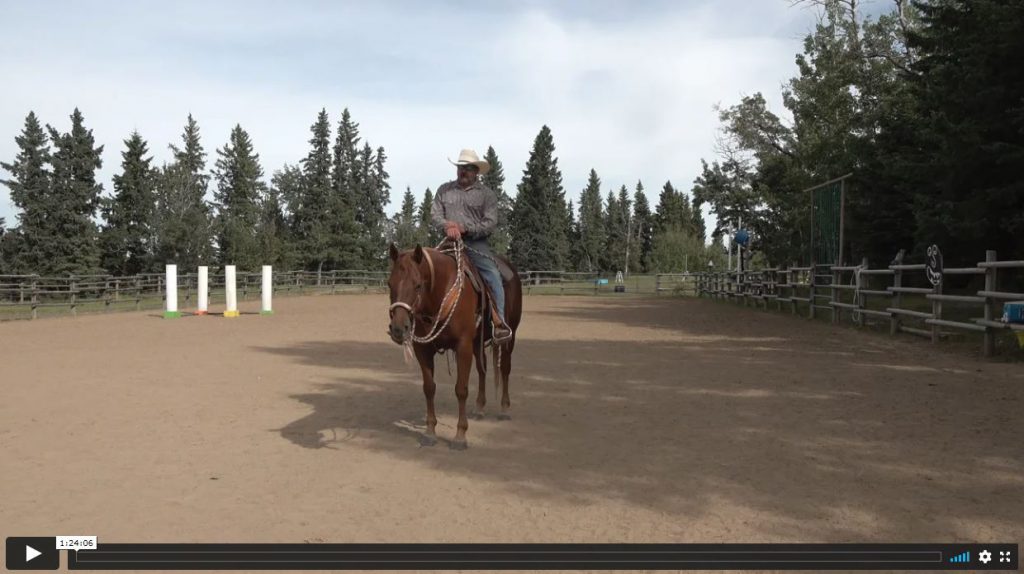An Issue of Confidence
Riding or working with an anxious horse can be intimidating, especially if we’ve had a mishap or suffered an injury. It’s important to recognize that when our horse spooks, they’re also struggling with a confidence issue. But as a team, we can work through these struggles together as we build strength in our relationship.
When a horse is nervous, they need to rely on our confidence and leadership. But we can’t just turn on confidence, like flicking a light switch. We certainly can, though, work through some exercises to build it, mutually, with your horse. Confidence comes when you believe you can change the outcome of a situation; when you know you can create success.
Proactive versus Reactive
To set the stage, consider learning to drive. We can be proactive: learning how to be attentive to the situation around us, intimately knowing our vehicle and lots of practice in judging and negotiating situations that have the potential to be unsafe. That way we avoid accident scenarios. Reactive training would be teaching us only to manage our vehicle after it was out of control.
When we class a horse as spooky, we’re really referring to their anxiety. A horse that’s anxious can be a liability as we might feel our safety is jeopardized. Often we’re only taught how to respond after the fact, for example with a one rein stop. However that is entirely reactive and doesn’t address the obvious problems:
1) The horse has reached their pressure limit and is responding instinctively;
2) The horse does not know they can follow us in pressure situations.
A proactive alternative is to show the horse not only that they can follow us, but that they can do so under increasing levels of pressure. That way, we’re doing our best to prevent spooks from happening in the first place. We also have the added advantage that when our horse becomes anxious, they defer to following us.

Changing How We Respond
Each horse is a unique individual and can handle a certain level of pressure. When that pressure level is exceeded, the horse will resort to instinctive behaviours: free, freeze or fight. Humans behave the same way.
When riding a spooky horse, we’re typically our own worst enemy. When a horse spooks at something, they will likely focus on the thing (freeze) or run from it (flee). In both cases, however, our typical response is to focus on the horse, or the scary thing. We’ll look down, thinking, “What are you doing? What’s going on?” But it’s in that moment that our horse needs us to lead them. And to lead them we need to focus on the solution, not the problem.
So what exactly is leading, then? We have the opportunity to lead every time we’re with our horse, from leading on the ground to leading in the saddle. Leading simply means that we’re providing a focus and energy that the horse can follow. And horses are already experts at following. Which means the onus is on us to lead.
What we desire is that our horse follow us under all circumstances. Consider horses in a herd. When a pressure is presented, say, something moving in the trees, they will follow the herd leader. If the herd leader sticks his head back down in the grass to eat, the rest of the herd will follow. Likewise if he takes off at a gallop, they’ll do the same.

What we take away from this is that we need to present ourselves like a leader our horse will want to follow. To accomplish this, first our horse must understand we’re above them in the herd. This will promote their following us, not their own instincts, when a pressure situation happens.
Herd order is determined by ownership of, and clarity in, space. To conceptualize space, think of your personal space. That is something that you own; it’s a part of you. Horses primarily communicate through space, so learning that language is fundamental. In our clinics and training we use some simple exercises to accomplish this. When conducting these exercises, we remain positive; we want our horse to understand that moving with us or yielding to us is a good thing.
Then we really begin to develop trust. Trust is a journey. Our horse might understand we’re above them in the herd order, but not trust us. We can rapidly earn trust by presenting pressures to the horse and in each case, showing them that following us is the answer. But in order for them to follow us, we need to be good at leading, and that starts with our own focus.
Here’s a game you can play, both on your horse and in the groundwork, to train yourself to change your focus and energy when you need to. For this exercise, you’ll need a friend to help you out. You’ll start by riding or doing groundwork. While you do that, your focus should strongly be on where you are going – like it always should be. Your friend, at some random moment, will yell something out like “Sasquatch!” In that moment, relax and exhale, look up, focus on where you want to go and ride there with intent. Pick a spot like a tree, a post in the arena or a spot on the horizon. What you’re doing is training an autonomic response in yourself: that when something spooky pops up, right away you focus on a way out and lead. You don’t need to add pressures that will spook your horse for this game; this is simply about you programming yourself how to respond.
Changing How Your Horse Responds
A horse is a born follower that instinctively excels at following the focus and energy of the leader. This gives us a fantastic tool.
First, it’s imperative that we do not teach our horse to ignore pressure nor teach them to always stand still. That is similar to continuing to blow up a balloon after it’s full – eventually it won’t be able to hold any more air and it will explode. The response we train instead is that the horse acknowledge and manage pressures – under our leadership. I mentioned that horses’ instinctive behaviours are to freeze, flee or fight. To accomplish our goal, we’ll introduce them to a new behaviour: releasing tension and following our focus.

In our training style we start off by introducing a basic pressure to our horse, then asking them to release tension and focus on us (maintaining eye contact). We’ll work that up through progressions of pressure, distance, position and gait. What we’re looking for is that whenever, wherever and however a pressure is introduced, our horse does not become tense or anxious, and looks to us for direction. This starts in the groundwork and progresses to the saddle.
Pressures we can play with include things our horse can walk through or over, see, smell, hear and feel. Our obstacle course and games are excellent for introducing a wide variety. Pressures can also:
- Be stationary, come toward or move away,
- Be random or rhythmic,
- Be close or at a distance,
- Vary in intensity.
It’s important that when we conduct pressure exercises, we proceed in small increments and only institute one change at a time. That way we can easily see when our horse struggles and if necessary, go back a step. When playing pressure games with horses, we need to see two very important things:
- The horse releases tension. We see this as a lowering of the head, or softening of the eye or jaw. This is something we need to teach the horse to do. We do that in part with a tiny rhythmic feel in the lead rope or rein, and in part by doing it ourselves: if we relax and breathe when introducing a pressure, our horse will be more likely to do so.
- The horse looks at or changes their focus to us. If our horse does not have a focus on us, they’re likely focusing on their escape route. We desire that they stick with us, particularly when we’re on their back.
As horsepeople, as leaders, we accept responsibility for our horse’s fears and anxieties. That way, we open the door to helping them through their struggles. In doing so, we establish a relationship based on trust that has been cultivated through positive training. A relationship where your horse understands they can always rely on you and follow you in any circumstance.
Check out the full length video where Scott explores the topic with demonstrations and exercises you can work on.

If you’d like to dig into these concepts more, check out the Following Under Pressure and Riding “Spooky” – Anxious Horses video series on our website at amazinghorsecountry.com.
Scott Phillips
October 2020
